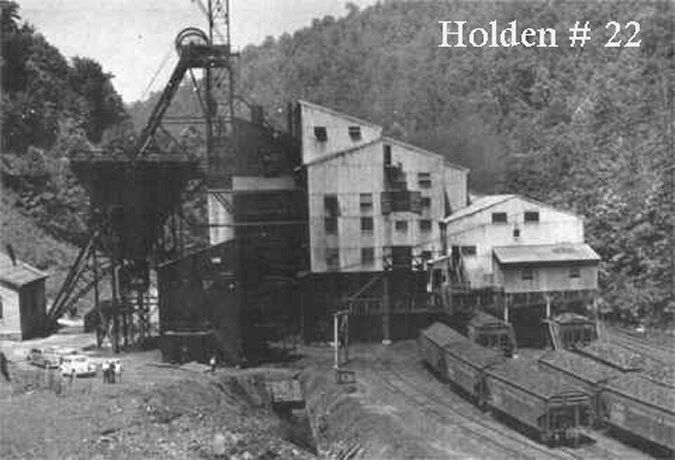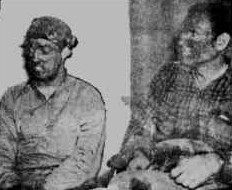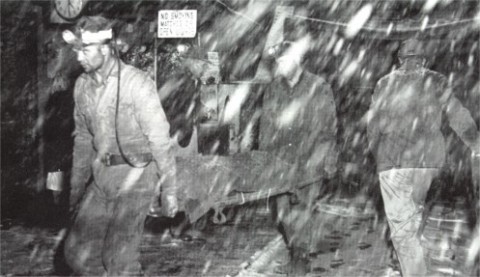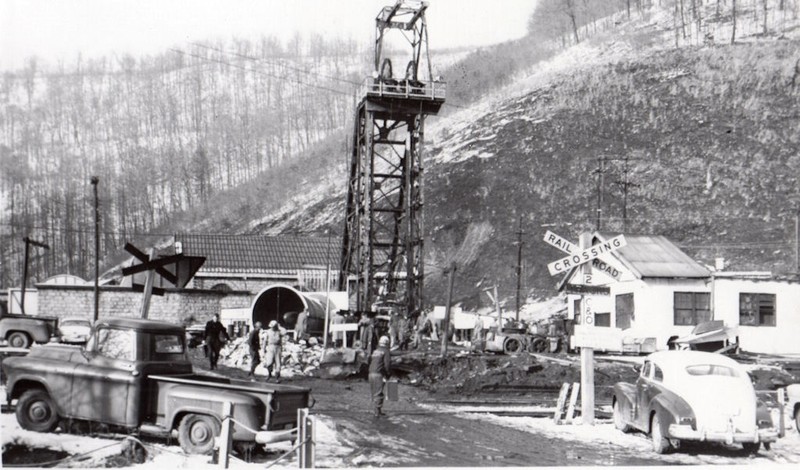Island Creek No. 22 Mine Disaster
Introduction
Text-to-speech Audio
Images
Island Creek No. 22 Mine

Kyle Blair and Willis Carter shortly after they reached the outside

A heavy driving snow blanketed the area as a victims were brought to the surface.

Holden, WV March 8, 1960 Island Creek No. 22 Mine where 18 miners were killed.

Backstory and Context
Text-to-speech Audio
The men were sealed off from the fire by the slate fall. Rescue workers poured water into the mine using as many as twelve different water-hose, but freezing temperatures soon froze the lines on the surface. Finally, when the fire was contained, teams of 40 men working around the clock slogged though knee-deep water in the smoke and steam hoping to rescue the men.
Veteran rescue workers called it "hell's fire." Ventilation expert, Willis Carter who was one of the trapped miners, volunteered to crawl through a narrow passageway to try an find a way out. A young miner, Kyle Blair agreed to follow him. The others decided to wait for fire fighters and the rescue team. Carter said Blair Blacked out for about twenty-five minutes as they crawled toward the surface. After that, Carter's repeated remarks of encouragement kept Blair moving with him through a circular route in old mine workings. When they finally reached safety, Blair said he remembered little of their four hour ordeal except that Willis kept talking. Blair said, "I just grabbed the right man."
Carter was asked if there was panic among the men. He said, "No, I don't think so, except for a time right at the first. I thought Donaldson was in some sort of shock. He wouldn't even answer me when I told him the men could not get out through the Elk Creek Slope. He kept telling Josh Chafin, a section foreman, to take his men and head for the Elk Creek Slope." Donaldson was a safety inspector who just happened to be with them when the fire broke out. Company officials hoped he could direct survival tactics by putting up brattices (canvas walls) to block off heat and fumes. Carter said he thought all of the men could have escaped if they had followed him.
Eight days after the fire began rescue workers came upon 13 bodies. All had died within hours after the accident of carbon monoxide gas. None of the bodies were burned, and the men appeared to have been relaxed when death made its silent approach. Two men were eating from their lunch buckets. One man was found in a kneeling position with his arms encircling a timber, and was apparently praying when he was over-come with the deadly gas. Freda Enyart Horvath, wife of Berti, believed this to be her husband, and wrote him a goodbye letter after she heard the news.
Josh Chafin, Jr. of Pine Creek was found still clutching the note he had written to his wife. The note was delivered to his wife twelve hours before the first body was brought to the surface. The note read: Mable, I love you more than you will ever know. Take care of the kids and raise them to serve the Lord.” It was signed, “Jr.” . . . the name he went by. Josh and his wife were members of the Central Baptist Church on Holden Road.
The bodies were wrapped in blankets and plastic bags, and carried to the base of a 485-foot elevator shaft. They were lined up neatly to await their return to the surface. A heavy wet snow fell covering the ground. The men were taken to the Harris Funeral Home which was chosen as a central station where families could claim the remains and make funeral arrangements. The last two miners to be recovered were Charles Adams and Louis Workman.
It took nine days to recover the bodies. Seventy-two children were left fatherless and sixteen wives were made widows by the mine disaster. The following is the list of miners who perished at 22 Holden:
Charles Adams, 46; Frank Ardis, 63; Ernest Bevins, 35; Okey Bryant, 49; James Carter, 30; Josh Chafin Jr., 37; Roy Lee Dempsey, 52; William Donaldson, 53; Garfield Hensley, 43; Berti Horvath, 32; Flint Lock Jarrells, 39; Albert Marcum, Jr.; Melvin Newsom, 46; Isom Ooten, 43; James V. Lundell, 26; Orville Sargent, 32; Carl White, 39; and Louis Workman, 32.
Ironically, Kyle Blair who escaped death at the Island Creek No. 22 mine disaster, died tragically in another mining accident about 1974. He was a mine foreman on the tipple at a Boone County mine, and fell into a coal crusher.
